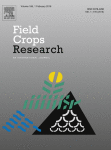Ver ítem
- xmlui.general.dspace_homeCentros Regionales y EEAsCentro Regional Buenos Aires SurEEA BalcarceArtículos científicosxmlui.ArtifactBrowser.ItemViewer.trail
- Inicio
- Centros Regionales y EEAs
- Centro Regional Buenos Aires Sur
- EEA Balcarce
- Artículos científicos
- Ver ítem
Soybean shows an attenuated nitrogen dilution curve irrespective of maturity group and sowing date
Resumen
It is generally accepted that the nitrogen (N) dilution curves relating shoot nitrogen concentration (%N) and shoot biomass (W) are similar among genotypes from the same species. However, differences in the pattern of biomass ratio between lamina and stem (Wlam:Wste) with increasing biomass would change the curve. Shoot biomass at flowering also affect biomass and N allocation in legumes and would affects the N dilution. In soybean, maturity groups (MG)
[ver mas...]
It is generally accepted that the nitrogen (N) dilution curves relating shoot nitrogen concentration (%N) and shoot biomass (W) are similar among genotypes from the same species. However, differences in the pattern of biomass ratio between lamina and stem (Wlam:Wste) with increasing biomass would change the curve. Shoot biomass at flowering also affect biomass and N allocation in legumes and would affects the N dilution. In soybean, maturity groups (MG) or sowing dates can lead to differences in Wlam:Wste and in time from sown to flowering and hence the parameters of N dilution curves could be affected. The aims of this study were: (i) to determine the growth and allocation patterns of soybean as affected by maturity group (MG IV vs II) and sowing date and (ii) to establish allometric relations between growth and nitrogen, including N dilution curves. Our working hypothesis is that the reference N dilution curve in soybean is similar to the critical N dilution curve of non-legume C3 crops.
Four experiments were performed at Balcarce, Argentina during three growing seasons with the aim to generate a wide range of growing conditions. Two soybean cultivars were evaluated: DM2200 (MG II) and DM4970 (MG IV), sown in optimum dates for the region (mid-November). DM2200 was also sown late (early January). We sampled crops between W ≈ 1 Mg ha−1 and R5. Shoots were separated in three compartments: lamina (Wlam), stem and petiole (Wste) and pod (Wpod).
Despite the marked decrease in Wlam:Wste with increasing biomass, the N dilution curve was attenuated in soybean, with no differences among cultivars of maturity groups II and IV, and sowing dates from November to January. We propose that early pod onset and the constant%N in lamina and stem between R1 and R5 attenuated the N dilution curve in all MG and sowing date. Timely-sown MGIV showed a greater Wlam:Wste ratio at W = 1 Mg ha−1 and a more pronounced depletion of the ratio with increasing biomass. However, the N dilution curves were similar between maturity groups II and IV, and sowing dates from November to January. This could be attributed to the lower%N in lamina at V6 in comparison to R1 in timely-sown MGIV.
[Cerrar]

Autor
Divito, Guillermo Adrián;
Echeverria, Hernan Eduardo;
Andrade, Fernando Hector;
Sadras, Victor Oscar;
Fuente
Field crops research 186 : 1-9. (February 2016)
Fecha
2016-02-01
ISSN
0378-4290
Formato
pdf
Tipo de documento
artículo
Palabras Claves
Derechos de acceso
Restringido
 Excepto donde se diga explicitamente, este item se publica bajo la siguiente descripción: Creative Commons Attribution-NonCommercial-ShareAlike 2.5 Unported (CC BY-NC-SA 2.5)
Excepto donde se diga explicitamente, este item se publica bajo la siguiente descripción: Creative Commons Attribution-NonCommercial-ShareAlike 2.5 Unported (CC BY-NC-SA 2.5)

